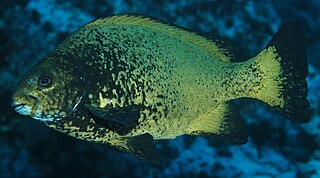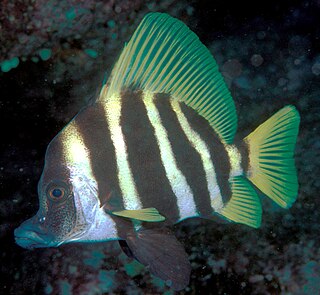The spikey bass is a species of ray-finned fish in the family Latidae, the lates perches. It is endemic to coastal waters off Western Australia, where it inhabits areas with soft substrates. It is the only species in the monotypic genus Hypopterus.

The sea chubs are a family, Kyphosidae, of fishes in the order Perciformes native to the Atlantic, Indian and Pacific Oceans usually close to shore in marine waters.

The striped boarfish, also known as whiskered boarfish, Japanese boarfish, sailfin armourhead or whiskered armorhead, is a species of marine ray-finned fish, an armourhead om the family Pentacerotidae, which is native to the Pacific Ocean from the Hawaiian Islands westward to the coast of Asia and Australia. This is a reef-dwelling fish found at depths between 18 and 193 m. It can reach a total length of 90 cm (35 in). It is currently the only known member of the genus Evistias.
Nannoperca is a genus of temperate perches endemic to Australia.

Characodon is a genus of splitfins endemic to north–central Mexico. Two of the species are highly threatened and restricted to pools, ponds and springs in the upper San Pedro Mezquital River basin in Durango. The third species, C. garmani, was restricted to springs near Parras in Coahuila, but it became extinct when they dried out.
The lined silverside is a species of fish in the family Atherinidae. It is found in Indonesia and the Philippines. This species was described as Atherina lineata by Albert Günther in 1872 with the type locality given as Cebu.

Craterocephalus is a genus of small and slender brackish or freshwater silversides from Australia and New Guinea. It is the most diverse genus in the family Atherinidae, containing 25 of the 71 species.
The Chapultepec splitfin, known locally as mexcalpique, is a critically endangered species of fish in the family Goodeidae. It is endemic to Mexico and was originally restricted to lakes and wetlands in the Valley of Mexico, including Lake Texcoco. Through man-made channels it was able to spread to the upper Pánuco River basin. Most native populations disappeared as they were at or near Mexico City, with the waters either being reclaimed, drained, heavily polluted or infested with introduced species. Today the Chapultepec splitfin is only known to survive in three lakes in the Chapultepec park of Mexico City, Lake Xochimilco, Lake Zumpango, Laguna de Tecocomulco northeast of the City where perhaps introduced, and parts of the Pánuco River basin. Most of these remaining populations are small. This species was originally described as Cyprinus viviparus in 1837 by Miguel Bustamante y Septién with the type locality given as "Mexico". In 1860 Pieter Bleeker raised the genus Girardinichthys with a new species Girardinichthys viviparus as its type species, this subsequently proved to be a taxonomy of Cyprinus viviparus.
The katrana is a species of fish in the Bedotiidae family. It is endemic to the basin of Lake Alaotra in Madagascar. Its natural habitats are rivers and freshwater lakes. It is threatened by habitat loss. This species was described by Jacques Pellegrin as Atherina alaotrensis with the type locality of Lake Aloatra.
Teramulus waterloti is a species of silverside from the [[subfamily Atherinomorinae which is endemic to Madagascar. This species occurs in rivers, creeks, and streams in north western Madagascar from the Mananjeba River south to the Anjingo River. The IUCN classify this species as Endangered and it is threatened by deforestation which degrades its habitat through sedimentation and by the introduction of invasive fish species such as Channa maculata. This fish was described in 1932 as the subspecies waterloti of Atherina duodecimalis by Jacques Pellegrin who named it after Georges Waterlot (1877-1939), a collector of specimens in Africa and Madagascar for Muséum national d'histoire naturelle, including the type of this species, which he collected from Antikotazo Creek, District d'Ambilobé, Diégo Suarez Province.

Trinorfolkia clarkei, known commonly as the Clarke's triplefin or Clarke's threefin, is a species of triplefin blenny in the genus Trinorfolkia. It was described by Alexander Morton in 1888 from specimens collected from Clarke Island in the Bass Strait. This species occurs I southern and western Australia from Camden Haven in New South Wales to Rottnest Island in Western Australia and around Tasmania. It occurs on coastal reefs and in estuaries frequently being observed around the pylons supporting structures such as jetties.
Trinorfolkia incisa, known commonly as the notched triplefin or notched threefin, is a species of triplefin blenny in the genus Trinorfolkia. It was described by Rudie Kuiter in 1986. This species is found at depths of between 10 and 30 metres on the roofs of caves. This species occurs along the southern coast of Australia from the south western coast of Western Australia to Victoria and around Tasmania.
Atherinosoma is a genus of silversides from the coastal waters of south-eastern Australia.

The stripey, also known as the footballer or convict fish, is a species of ray-finned fish, a sea chub from the subfamily Microcanthinae which is part of the family Kyphosidae. It is native to the Pacific Ocean where it has a wide range. This species may be found in the aquarium trade. It is the only known member of its genus.
Membras martinica, the rough silverside, is a species of Neotropical silverside from the family Atherinopsidae, it is the type species of the genus Membras.
The panatela silverside is a species of reef-dwelling silverside from the subfamily Atherinomorinae which is found in the southwest Pacific Ocean. This species grows to 11 cm (4.3 in) in total length and is of minor importance to commercial fisheries. This species is the only species in the genus Stenatherina, although some authorities place it in the genus Hypoatherina. This species was described by David Starr Jordan and Robert Earl Richardson as Atherina panatela with the type locality given as Calayan Island in the Philippines. The specific name is the Spanish word for a long, thin cigar and is presumed to be a reference to the elongated, slender body of this fish.

Acropoma japonicum, the glowbelly, is a fish species in the family Acropomatidae found in the Indo-West Pacific. It is a benthopelagic predatory fish with a bioluminescent organ on its ventral surface. The glowbelly is an important food fish in some areas.
Atherinosoma elongata, the elongate hardyhead, is a species of silverside from the family Atherinidae. This species is found in shallow estuaries, sheltered bays, inlets, lagoons and estuaries in southwestern and southern Australia from the Bowes River in Western Australia to Nelson in southwestern Victoria with a gap which runs from Point Demspter in Western Australia and Fowlers Bay, South Australia. This species was described as Atherina elongata in 1879 by Carl Benjamin Klunzinger with a type locality of King George Sound in Western Australia.

Cymolutes praetextatus, the knife razorfish or knife wrasse, is a species of ray-finned fish from the family Labridae, the wrasses. It occurs in the Indo-Pacific where it occurs over reef flats and in shallow lagoons.

Stethojulis strigiventer, also known as the three-ribbon wrasse, silverstreak wrasse, silverbelly wrasse, lined rainbowfish or silver-streaked rainbowfish, is a species of marine ray-finned fish, a wrasse from the family Labridae. This species occurs in beds of seagrass and areas of inner reefs and shallow lagoons where there is a substrate consisting of mixed sand, rubble, and algae. It is found in small groups which swim over large areas down as deep as 20 metres (66 ft). The range of this species extends from the Red Sea southwards along the eastern coast of Africa to Algoa Bay in KwaZulu-Natal, South Africa and eastwards to the Marshall and Tuamotu islands, it also extends north to Honshu and south to New South Wales. This species was first formally described as Julis strigiventer in 1833 by the English zoologist Edward Turner Bennett (1797-1836) with the type locality given as Mauritius. When Albert Günther created the genus Stethojulis he designated Julis strigiventer as the type species.








